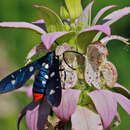fi
nimet breadcrumb-navigoinnissa


The oleander caterpillar is abundant.
US Federal List: no special status
CITES: no special status
Because of their "skeletonizing" feeding behavior, they leave the leaf veins alone, but devour the tissue in between. This causes the oleander to be more susceptible to other insects and also causes asthetic damage to the oleander.
The oleander caterpillar doesn't posess any direct positive attributes for humans. It does, however, contribute to the food chain in many important ways which affect humans.
This caterpillar's diet consists mainly of the leaves of the oleander plant on which it lives. During the earlier portion of its larval stage, it feeds on the undersides of the leaves, but as it grows into a mature larva, it can consume the entire leaf, except for the veins.
Syntomeida epilais lives in Caribbean climates and its range extends from South America to Central America, and into Mexico. It also spans from the Caribbean to Florida and some of southeastern United States.
Biogeographic Regions: nearctic (Native ); neotropical (Native )
The range of this organism is from the Caribbean islands to Florida, and from upper South America into Mexico. The Syntomeida epilais lives anywhere that the oleander lives naturally, except for California. It flourishes, however, in southern Florida. Its original host plant is thought by many to be the Echites umbellata.
Terrestrial Biomes: savanna or grassland ; forest ; rainforest
In the larval stage, the oleander caterpillar is a bright orange, much like the flower it is named after. It has bristly black hairs, and is about 3 to 40 mm long. In its adult stage, its body and wings are an incandescent blue-green with white polkadots, and its abdomen is red-orange. It has a wingspan of 45-51mm.
Other Physical Features: ectothermic ; bilateral symmetry
Syntomeida epilais reproduces sexually, mating and laying their eggs on the undersides of the leaves of the oleander. Egg clusters can range from 12 to 75 eggs which are less than 1 mm in diameter. They hatch into larvae that are anywhere between 3 to 44mm. The larval stage is further divided into instars. The first instar hatches in a few days, depending on climatic temperature. The second and third instar eat a great deal and move down the oleander; this stage lasts around 8.5 days on average. The fourth instar is the only one that can eat other parts of the leaf as opposed to just the underside. During the fourth, fifth, and sixth instar, they eat alone. Then they search for a location to pupate. They then become a pupa and are smooth and brown. They are covered in a thin cocoon that they make from silk and their hair. Finally, they hatch into the adult moth. Generally, there are three generations of Syntomeida epilais a year.
Syntomeida epilais, the polka-dot wasp moth or oleander moth, is a species of moth thought to be native to the Caribbean.[1] Its larvae feed on the oleander plant. Like most wasp moths, these are day fliers.[2]
They prefer Neotropic areas, to which they are native. The North American subspecies is S. epilais jucundissima, which is locally common in all areas of Florida, and has been seen as far north as South Carolina,[2] and west to Mississippi and Texas.[3]
They are dark metallic blue with white polka-dots on the wings and upper abdomen, and the tip of the abdomen is bright red. This mimicry makes it look like a dangerous wasp, while in fact being a harmless moth. The caterpillars are orange or dark orange with long black hairs making the caterpillars look dangerous, but the setae do not inflict any harm.[1][2]
Females contact male polka-dot wasp moths by means of ultrasonic signals. On the branch, the sound travels, and then the male follows the sound to his new mate. When he reaches her, he emits an answering signal.[4] After mating, the females find a plant on which to lay their eggs. Groups of from 12 to 75 eggs are laid on the undersides of the oleander leaves.[4] The spherical eggs are pale cream to light yellow in color; each is less than 1 mm in diameter.[4]
The larvae stage of the polka-dot wasp moth, commonly called the oleander caterpillar, is widely known for its gluttonous appetite. The caterpillar feeds in almost any location (excepting California) where its food, the oleander plant, can be found. They are gregarious and can cause damage from minor to severe. It may also feed on devil's potato plants, which are believed to be its native food before the oleander plant was introduced to the Americas by Spanish settlers in the seventeenth century.[1] They also feed on desert rose plants.[5]
Syntomeida epilais, the polka-dot wasp moth or oleander moth, is a species of moth thought to be native to the Caribbean. Its larvae feed on the oleander plant. Like most wasp moths, these are day fliers.
They prefer Neotropic areas, to which they are native. The North American subspecies is S. epilais jucundissima, which is locally common in all areas of Florida, and has been seen as far north as South Carolina, and west to Mississippi and Texas.
Syntomeida epilais est une espèce américaine de lépidoptères (papillons) de la famille des Erebidae et de la sous-famille des Arctiinae.
Sa chenille est surnommée « chenille rasta » dans les Antilles.
Une chenille de Syntomeida epilais.
Syntomeida epilais est une espèce américaine de lépidoptères (papillons) de la famille des Erebidae et de la sous-famille des Arctiinae.
Sa chenille est surnommée « chenille rasta » dans les Antilles.
Une chenille de Syntomeida epilais.